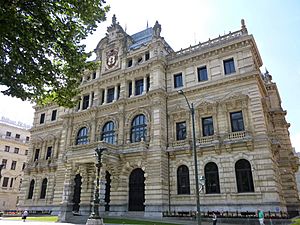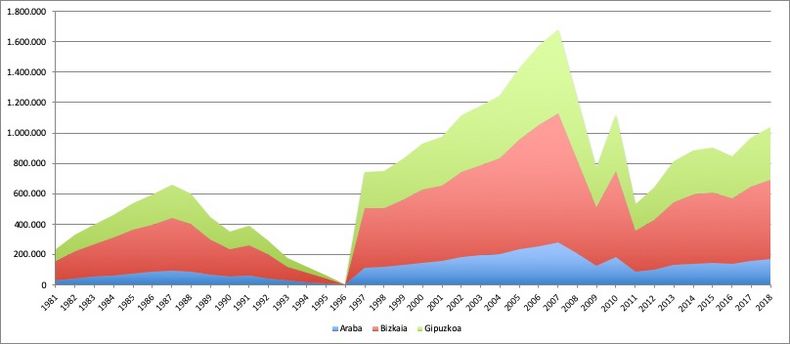Basque Economic Agreement facts for kids
The Economic Agreement (also known as Concierto Económico in Spanish or Kontzertu Ekonomikoa in Basque) is a special arrangement. It explains how the Basque Country and the government of Spain share money and taxes. This agreement sets the rules for how the Basque Country collects its own taxes and how much money it contributes to the Spanish government.
Contents
How the Agreement Started
The First Years: 1878–1937

The Economic Agreement began in 1878, after a war called the Third Carlist War. Spanish troops occupied the Basque Provinces (Álava, Gipuzkoa, and Biscay). Before this, the Basque regions had their own special laws and tax systems, known as Fueros.
After the war, Spain wanted everyone to pay taxes the same way. But the Basque regions had their own local governments, called Diputaciones Forales. These governments used to collect their own taxes. The Spanish government and Basque leaders had to find a new way to manage taxes.
In February 1878, they reached a deal. The Basque provinces would collect taxes themselves. Then, they would pay a set amount, called the "Quota," to the Spanish government. The Basque governments could keep any extra money they collected. This system was meant to be temporary, but it kept being renewed for many years.
Over time, the number of taxes covered by the agreement grew. As the Basque economy became stronger, especially in Biscay with its mining and shipbuilding, the Quota paid to Spain also increased.
| Year | Biscay | Gipuzkoa | Álava | Total |
|---|---|---|---|---|
| 1878 | 857,8 | 655,8 | 529,6 | 2.043,2 |
| 1887 | 1.286,6 | 983,7 | 529,6 | 2.799,9 |
| 1894 | 2.557,0 | 1.446,1 | 597,7 | 4.600,8 |
| 1898 | 3.006,0 | 1.706,3 | 693,7 | 5.406,0 |
| 1899 | 2.617,0 | 1.486,3 | 602,7 | 4.706,0 |
| 1900 | 2.703,7 | 1.490,6 | 603,7 | 4.797,9 |
| 1904 | 2.553,1 | 1.373,9 | 548,1 | 4.475,1 |
| 1906 | 4.984,0 | 2.066,5 | 623,2 | 6.988,1 |
| 1913 | 4.388,4 | 2.066,5 | 623,2 | 7.078,1 |
| 1916 | 4.709,4 | 2.226,5 | 642,1 | 7.578,1 |
| 1920 | 6.999,4 | 2.411,5 | 667,1 | 10.078,1 |
| 1926 | 28.380,0 | 10.050,0 | 1.570,0 | 40.000,0 |
| 1932 | 28.734,0 | 10.177,0 | 1.589,0 | 40.500,0 |
Amounts are in thousands of Pesetas, the old Spanish currency.
The Basque governments had a lot of freedom. They could decide how to collect taxes and spend money without needing permission from the Spanish government.
However, this changed in 1937 during the Spanish Civil War. The Economic Agreement was cancelled for Biscay and Gipuzkoa because they supported the losing side. But it stayed in place for Álava.
The Agreement in Álava: 1937–1980
For many years, from 1937 to 1980, the Economic Agreement only applied to the province of Álava. The agreement was updated several times to fit new tax rules in Spain. Álava continued to collect its own taxes and pay a Quota to the central government.
The Modern Agreement: 1981–Today
After the end of the dictatorship in Spain and the start of democracy, people in the Basque Country wanted more self-governance. The new Spanish Constitution of 1978 recognized the historical rights of regions like the Basque Country. One of these rights was the Economic Agreement.
So, in 1981, the Economic Agreement was brought back for the entire Basque Autonomous Community.
Key Features of the 1981 Agreement
The 1981 agreement was special because it was approved as a "Single Article Law." This meant its content could not be changed easily; it had to be accepted or rejected as a whole.
The agreement had two main parts:
- Taxes: It explained which taxes the Basque Country could collect and how. The Basque local governments (the Diputaciones Forales) were given the power to manage, collect, and decide on many taxes. These included important taxes like income tax, company tax, and sales tax (VAT).
- The Quota: The biggest change was how the Quota was calculated. Before, it was based on how much the Spanish government might have collected. Now, the Quota became the Basque Country's payment for services that the Spanish central government still provides in the Basque region, such as defense or diplomatic services. It also included a contribution to a national fund for balancing wealth between regions.
The Quota was set based on the Basque Country's share of Spain's total income, which was calculated at 6.24%. This Quota was reviewed every five years, with yearly adjustments.
The agreement also created special groups to manage it:
- A Mixed Commission with equal members from the Basque Country and Spain. This group decides on changes to the agreement and the Quota.
- An Arbitration Board made of experts to solve any disagreements between the Basque and Spanish governments.
Updates to the Agreement
The Economic Agreement has been updated many times since 1981 to adapt to new situations. For example, it was changed when Spain joined the European Economic Community (now the European Union) and introduced VAT. It was also updated to include new types of taxes.
In 2002, a very important change happened: the agreement was made to last indefinitely. Before, it had a set end date, which often caused arguments when it was time for renewal. Now, it continues unless both sides agree to change it.
The 2002 agreement also gave the Basque Country even more power over its taxes. It also created a clearer structure for how taxes, financial relations, and the managing commissions work together.
The Economic Agreement is a unique system that allows the Basque Country to have a high level of financial independence while still being part of Spain.
See also
Basque tax holidays In Spanish: Concierto económico para niños
In Spanish: Concierto económico para niños





